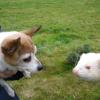-
Content Count
357 -
Joined
-
Last visited
Content Type
Profiles
Forums
Gallery
Articles
Gun Dealer's and Fieldsports Shop's
Reloading Room
Blogs
Calendar
Store
Classifieds
Everything posted by Meroman
-
Well done, its not been a great season for a lot of people I know including myself, a credit to you. Good luck with them.
-
Nice birds, they've got great colour in them.
-
Here's an article written by Paul Girvan a few years back. Every once in a while, a question from an eager novice or newcomer appears in Cage & Aviary Birds, asking how to breed mules from a Goldfinch or Siskin that they have just acquired. The limited space available means that the answer is usually restricted to basic hints on success in the art of muling. For many years now, i have taken great delight in trying to produce miniature mules. At first, i did so because i was fascinated by the idea of going against nature and breeding something both beautiful and uniq
-
What birds did you put in your new flight?
-
Good luck with them Gnipper, the goldie usually doesn't come into breeding condition until mid to late may so if you get an early round of blind eggs dont lose faith in the pair.
-
You've some nice birds there. Great to see goldies breeding in cages.
-
Tenbob I think its going to be one of those seasons, I've only bred three chicks from seven pairs (goldies,siskins and chaffies) so far and there's not that long left to turn it around so I'm not holding out much hope for the next few weeks.
-
Indeed Fireman I agree it has to be the weather... Good luck with the bullies, anyone I've spoken to here that's breeding them are not having much joy with them with one exception, a mate of mine is putting native bullie eggs under Siberian hens and they are rearing them for him...
-
My season so far has been bad to say the least. I have one chaffie and three siskins to the sticks at this point, I've had lots of clear eggs, hens jumping the nest because of thunderstorms at night (I assume) and nests being torn apart by cock birds in the same flight. I've also lost three birds since May which does not help. The clear eggs make me think I didn't get my birds into good breeding condition but I've done the same thing for years now with much better results. The joys of keeping Natives I suppose!!
-
Sorry to read that Keeper its always a challenge with natives......
-
Any success with the Goldie.siskin pairing Keeper?
-
Yes Neil, the South county show is one of the oldest cbs shows in Ireland and still going strong. The INBBS run their young stock show in conjunction with it the October bank holiday weekend and then have their main show the third weekend the following January every year... Both shows are well worth a visit...
-
Hope you get them to the sticks fireman....What livefood are you using?
-
A few photos of natives on the show bench at the South county show in Dublin & the INBBS show from a few years back...The last photo was taken at the London & home counties show the same year 2009 I think...
-

Breeding And Showing The Lesser Redpoll.
Meroman replied to Meroman's topic in Cage and Aviary Birds
I've only ever met him once, a true gentleman and a top birdman is Alan... -
An article written by Alan Haury. I have always had a great fondness for Lesser redpolls. A Lesser Redpoll cock was the very first bird that I owned. I was seven years old. This bird lived in an old budgie cage in the house and I fed it on mixed canary seed and family left overs !! The area I lived in had lots of Lessers. We had different names for them (Tillys – mountiers ). Many local birdmen would always try to obtain the ones with the red breast. You could obtain these birds for £1 a pair !!! As I got into my early teens I started to seriously breed British Birds (Goldies were the fi
-
Here's an article written by Jeff Hulme. I have been breeding my strain of Linnets in pens for about 10 years now. The pen sizes that I have found give my Linnets more security are about 3' 6" wide x 3' high x 18" deep. I have also bred them in pens that are about 4' x 2' x 2'. I line breed the Linnets, and have found that they are now becoming very steady, and are gradually improving in markings and size. The colour is still a problem and I would like to see darker birds. Last year my Linnets went to nest earlier than ever before and I had eggs at the beginning of April. Normally it
-
Good luck with the chaffie's I hope you are successful with them. I've kept them for years and only bred them twice. They are not an easy native to breed in my opinion. I'd keep an eye on the cock when the chicks hatch if he is rank he'll toss them out of the nest or break up the nest to get the hen down again. The chaffie eggs I put under a red canary weren't birded but the hen chaffie has built a nest this time round and is sitting on two eggs, one of which is birded so fingers crossed on that one...
-
These species profile articles were compiled by a good friend of mine namely John Carter, the info was gleaned from the internet and he put them together to show an accurate & condensed profile of the various native bird species. Bullfinch Pyrrhula pyrrhula Cock Bullfinch. General Overview: The male is unmistakable with his bright pinkish-red breast and cheeks, grey back, black cap and tail, and bright white rump. The flash of the rump in flight and the sad call note are usually the first signs of bullfinches being present. The female has a brown back and pinkish-fawn
-
I'm very late this year with my breeding season due to work so it hasn't really started in earnest yet. I have three flights 12ft x 5ft x 8ft in height two of which are sorted and have a pair of goldies, a pair of siskins and a pair of chaffies in each. The third flight has only a pair of chaffies in at the moment and I'm still sorting a few goldies and siskins that are in cages to fill the flight. The pair of chaffies that are alone are nine years old and due to be put in cages for the summer to free up the flight as they have not bred for the past two years due to age I reckon but last Thurs
-
You mention a siskin hen sitting as well. What size is the flight and how many birds are in it? Cock goldies & siskins are well known for interfering with sitting hens usually to drive the hens back down in my opinion. As fireman says... remove the cock until she has finished laying and is sitting tight.
-
Thanks lads, I'll keep posting this info as I get permission from the original authors... I dont want to overshoot the runway here but I wonder would admin consider creating a sub forum within ''cage & aviary birds'' to post all these articles then pin it so its always at the top otherwise these topics will eventually get lost in all the threads that are running. Just a thought mind, I'm only thinking aloud
-
Goldfinch Carduelis carduelis Adult Goldfinch General Overview: The average Goldfinch is 12-13 cm long with a wingspan of 21-25 cm and a weight of 14 to 19 grams. The sexes are broadly similar, with a red face, black and white head, warm brown upperparts, white underparts with buff flanks and breast patches (known as tannings), and black and yellow wings. On closer inspection male Goldfinches can often be distinguished by a larger, darker red mask that normally extends just behind the eye. In females, the red face does not usually extend beyond or behind the eye. The ivory-coloured
-
This is another article written by Sean Fitzpatrick. Breeding the Bramblefinch By Sean Fitzpatrick. My initial interest in Bramblefinches was sparked when I was given a particularly nice cock bird. This bird displayed all the attributes required in a Bramblefinch of exhibition quality and this spurred me on to try and breed this species. I acquired a hen bird as a prospective partner for the cock and awaited the onset of spring. An aviary measuring 6’X4’X6’ was prepared for the birds. The floor was concrete, covered in a litter of dried grass cuttings to provide
-
I find with siskins they generally start sitting tight after they lay the third egg so any subsequent eggs will hatch a day or two later than the rest. When this happens sometimes the last chicks to hatch struggle to get fed properly because their nest mates are bigger and stronger. Having said that I believe natives know when to start incubating their eggs so that in a lot of cases most if not all the eggs hatch the same day otherwise how do we see photos & videos of native bird nests in the wild with four or five chicks all the same size, the tit family are a good example. Different he



